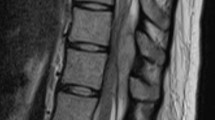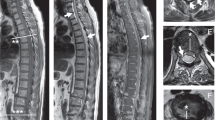Abstract
Introduction
Spondylodiscitis accompanying spinal epidural abscess is often treated with decompression surgery when there are neurological symptoms. We report a case of spondylodiscitis accompanying spinal epidural abscess with severe lower extremity pain that was successfully treated with percutaneous posterior pedicle screw fixation without decompression surgery.
Case presentation
A 53-year-old man was admitted to our hospital with severe low back pain (LBP), lower extremity pain and numbness, and fever. Lumbar magnetic resonance imaging (MRI) revealed spondylodiscitis at L2–L3 and a small epidural abscess located ventrally in the spinal canal. Initially, the patient was treated conservatively with empirical antibiotics. However, the lower extremity symptoms worsened and the epidural abscess expanded cranially to the T12 level. Percutaneous pedicle screw fixation without decompression was performed thirty-three days after admission. Postoperatively, the LBP and lower extremity pain dramatically improved. A postoperative MRI performed one week post-operatively showed an unexpectedly rapid decrease in the size of the epidural abscess, although no decompression surgery was performed. Two months after surgery, the epidural abscess completely disappeared. At the final follow-up (five years postoperatively), no recurrence of epidural abscess was observed, and the patient had no symptoms or disturbance of activities of daily living.
Discussion
This surgical strategy should be carefully selected for patients with spondylodiscitis with accompanying spinal epidural abscess who have lower extremity symptoms. The stabilising effect of pedicle screw fixation may be advantageous for controlling spinal infections. Percutaneous posterior pedicle screw fixation without decompression is an optional treatment for spondylodiscitis accompanying spinal epidural abscess.
Similar content being viewed by others
Log in or create a free account to read this content
Gain free access to this article, as well as selected content from this journal and more on nature.com
or
Data availability
The datasets generated during and/or analysed during the current study are available from the corresponding author on reasonable request.
References
Fantoni M, Trecarichi EM, Rossi B, Mazzotta V, Di Giacomo G, Nasto LA, et al. Epidemiological and clinical features of pyogenic spondylodiscitis. Eur Rev Med Pharmacol Sci. 2012;16 Suppl 2:2–7.
Taylor DG, Buchholz AL, Sure DR, Buell TJ, Nguyen JH, Chen CJ, et al. Presentation and outcomes after medical and surgical treatment versus medical treatment alone of spontaneous infectious spondylodiscitis: a systematic literature review and meta-analysis. Glob Spine J. 2018;8 Suppl:49S–58S.
Yoon SH, Chung SK, Kim KJ, Kim HJ, Jin YJ, Kim HB, et al. Pyogenic vertebral osteomyelitis: identification of microorganism and laboratory markers used to predict clinical outcome. Eur Spine J. 2010;19:575–82.
Reihsaus E, Waldbaur H, Seeling W. Spinal epidural abscess: a meta-analysis of 915 patients. Neurosurg rev. 2000;23:175–204.
Mackenzie AR, Laing RB, Smith CC, Kaar GF, Smith FW. Spinal epidural abscess: the importance of early diagnosis and treatment. J Neurol Neurosurg Psychiatry. 1998;65:209–12.
Eismont FJ, Bohlman HH, Soni PL, Goldberg VM, Freehafer AA. Pyogenic and fungal vertebral osteomyelitis with paralysis. J Bone Jt Surg Am. 1983;65:19–29.
Dobran M, Iacoangeli M, Nasi D, Nocchi N, Di Rienzo A, di Somma L, et al. Posterior titanium screw fixation without debridement of infected tissue for the treatment of thoracolumbar spontaneous pyogenic spondylodiscitis. Asian Spine J. 2016;10:465–71.
Lambert A, Charles YP, Ntilikina Y, Lefebvre N, Hansmann Y, Sauleau EA, et al. Safety and efficacy of percutaneous instrumentation combined with antibiotic treatment in spondylodiscitis. Orthop Traumatol Surg Res. 2019;105:1165–70.
Mohamed AS, Yoo J, Hart R, Ragel BT, Hiratzka J, Hamilton DK, et al. Posterior fixation without debridement for vertebral body osteomyelitis and discitis. Neurosurg Focus. 2014;37:E6.
Chen J, Xuan T, Lu Y, Lin X, Lv Z, Chen M, et al. Outcome of one-stage percutaneous endoscopic debridement and lavage combined with percutaneous pedicle screw fixation for lumbar pyogenic spondylodiscitis. J Orthop Surg. 2021;29:23094990211065579.
Duan K, Qin Y, Ye J, Zhang W, Hu X, Zhou J, et al. Percutaneous endoscopic debridement with percutaneous pedicle screw fixation for lumbar pyogenic spondylodiscitis: a preliminary study. Int Orthop. 2020;44:495–502.
Author information
Authors and Affiliations
Corresponding author
Ethics declarations
Competing interests
The authors declare no competing interests.
Additional information
Publisher’s note Springer Nature remains neutral with regard to jurisdictional claims in published maps and institutional affiliations.
Supplementary information
Rights and permissions
Springer Nature or its licensor holds exclusive rights to this article under a publishing agreement with the author(s) or other rightsholder(s); author self-archiving of the accepted manuscript version of this article is solely governed by the terms of such publishing agreement and applicable law.
About this article
Cite this article
Kubota, G., Aoki, Y., Sato, Y. et al. Unexpectedly rapid decrease in the size of a spinal epidural abscess after percutaneous posterior pedicle screw fixation without decompression surgery: a case report. Spinal Cord Ser Cases 8, 77 (2022). https://doi.org/10.1038/s41394-022-00543-5
Received:
Revised:
Accepted:
Published:
DOI: https://doi.org/10.1038/s41394-022-00543-5
This article is cited by
-
Meropenem
Reactions Weekly (2022)



